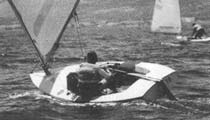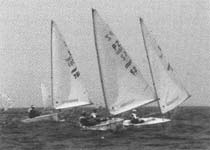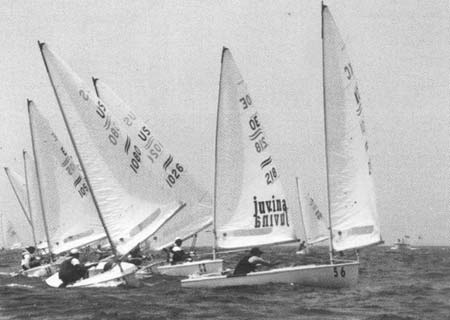41. Downwind Speed |
by Larry Lemieux |
|
Whenever you can catch a wave without pumping the sail, you automatically give yourself more options as to what you can do with the wave. Because the sail is out and pulling all the time you don't have to 'reload' it. You are powered up the whole time, so this allows you to keep control of the 'windward rock', which makes the boat more stable, makes it easier to steer the course that you want to and you also always have a 'reserve' if you need it. Here is the technique that works for me.
|
Downwind speed is a function of three things:
1 - the direction and amount you steer;
2 - the range you play your sail in;
3 - controlling the rock to windward.
You can't control how much you steer if you can't control the rock to windward.
|
 |
|
You can't control the rock to windward unless you're playing the sail in the right range and you can't play your sail in the right range if you're steering all over the place. They are all related.
The ideal course to steer is just a couple degrees either side of directly down wind. The boat is always more 'lively' when you're close to being square to the wind. You have to take advantage of this. When everything is balanced you should be able to feel added pressure on the main sheet when you let the boat rock up to windward. If not, then your sail is too far out. The amount you let the boat heal to windward depends on how far you want to bear away.
|

|
In order to control the windward rock you need to be playing the sail in the right range. The right range is when you let your main sheet out the length of your arm so that the boat starts to roll over on top of you. When you reach the desired angle you then pull in the sheet to flatten the boat. If you rock too far and consequently bear off too much then you will steer out of the effective trimming range of the length of your arm. It is very important not to steer too far away from dead down wind. This way, when you get in the groove it will be easier to keep it there. |
| To put this all together here is the sequence of movements. While sailing just a couple degrees from dead down wind you first let the sail out slightly which causes the boat to rock to windward. When the boat reaches the desired angle you 'catch it' by pulling the sail back in enough to stop the rock and maintain the desired angle. The desired angle is determined by how much you want to bear away as a result of the rock. |
|
Now the boat is on the wave, sailing slightly by the lee, heeled to windward. Because you haven't pumped in the sail to catch the wave it is still out and pulling as the boat bears away to sailing by the lee. This is very important because now the boat is going to rock back the other way, and because you're slightly by the lee, the flow across the sail is reversed and you get a second push from the sail as the boom comes down. As the boat flattens out it rounds up slightly putting you back to where you started from, ready for the whole routine to begin again.
When all three components of this technique are done properly then none of them need to be extreme. The rock doesn't have to be a big one, the boat doesn't have to bear away very far and the sail trimming range is only the length of your arm. When done correctly this technique is like the difference between paddling a canoe or a kayak. In a canoe you only use one end of the paddle. This is like giving the sail one big pump. In a kayak you use both ends of the paddle. This is the same as what I've described. |
 |
|
When you're set up correctly, you can not only get a push from the sail when the boat rolls over to windward but also when it rolls back. All the movements of the boat can therefore propel you forwards when you are set up properly. |
|
|